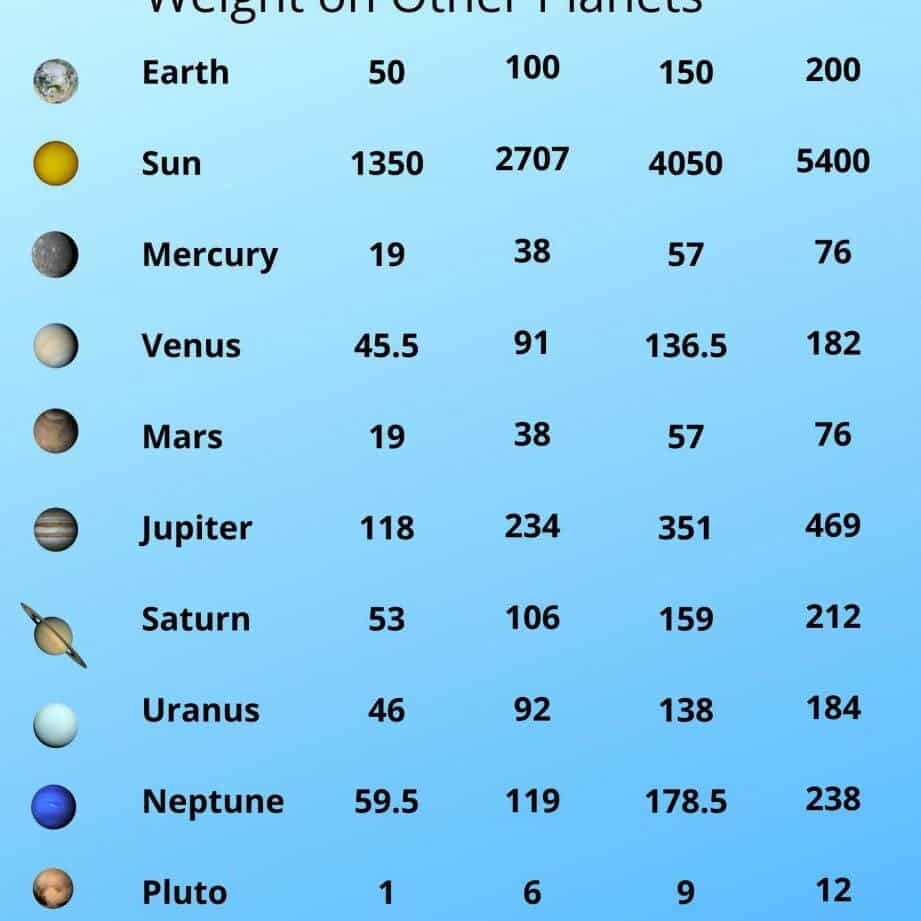Saturn, the stunning sixth planet from the Sun, is truly a sight to behold in our Solar System.
This gas giant, which is the farthest planet from its star, can be observed from Earth without the need for any special equipment. Consequently, humanity has been aware of its presence for a considerable length of time. Saturn occupies the sixth position among the four gas giants in our Solar System, with its distance from the Sun. If you are eager to learn more about the enigmatic planet Saturn, let’s first explore some intriguing facts about it.

Fascinating Information
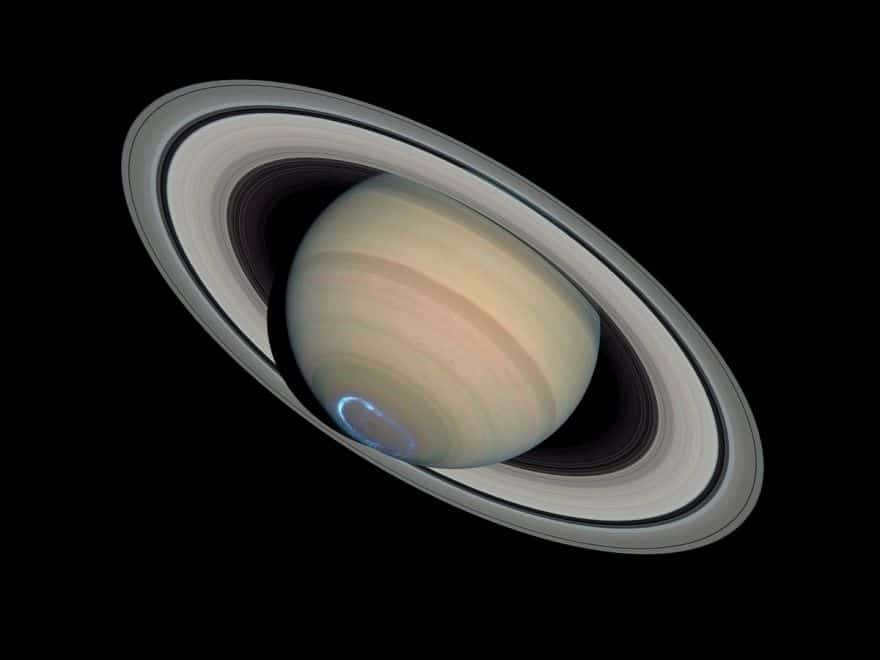
- Saturn is the fifth most luminous celestial body in our solar system, making it visible through binoculars or a telescope.
- It has been observed since ancient times, including by the Babylonians and people in the Far East. The planet is named after a Roman titan, similar to the Greek Kronos.
- The polar diameter of Saturn covers 90% of its equatorial diameter, which is due to its low density and rapid rotation. The planet completes one axial revolution every 10 hours and 34 minutes.
- The upper layers of Saturn’s atmosphere consist of ammonia ice, followed by water clouds and then cold mixtures of hydrogen and sulfur.
- The region above the northern pole of Saturn has assumed a hexagonal form, resembling a hexagon. Scientists speculate that this shape may be a result of a wave pattern occurring in the upper clouds. Additionally, there is a vortex present over the southern pole that bears resemblance to a hurricane.
- Saturn is composed of various layers which become denser as they penetrate deeper into the planet. At significant depths, hydrogen transitions into a metallic state. At the core lies a luminous interior.
- The rings of Saturn are comprised of ice fragments with a small amount of carbonaceous dust. These rings stretch across a distance of 120,700 km but are exceptionally thin, measuring only 20 meters in thickness.
- Saturn’s moons consist of icy worlds, with Titan and Rhea being the largest among them. Enceladus is believed to potentially house a subsurface ocean.
- This celestial body is mainly composed of ice and rock, with its frozen surface layer containing lakes of liquid methane and landscapes covered in frozen nitrogen. It is speculated that this moon may harbor life.
Dimensions, weight, and path
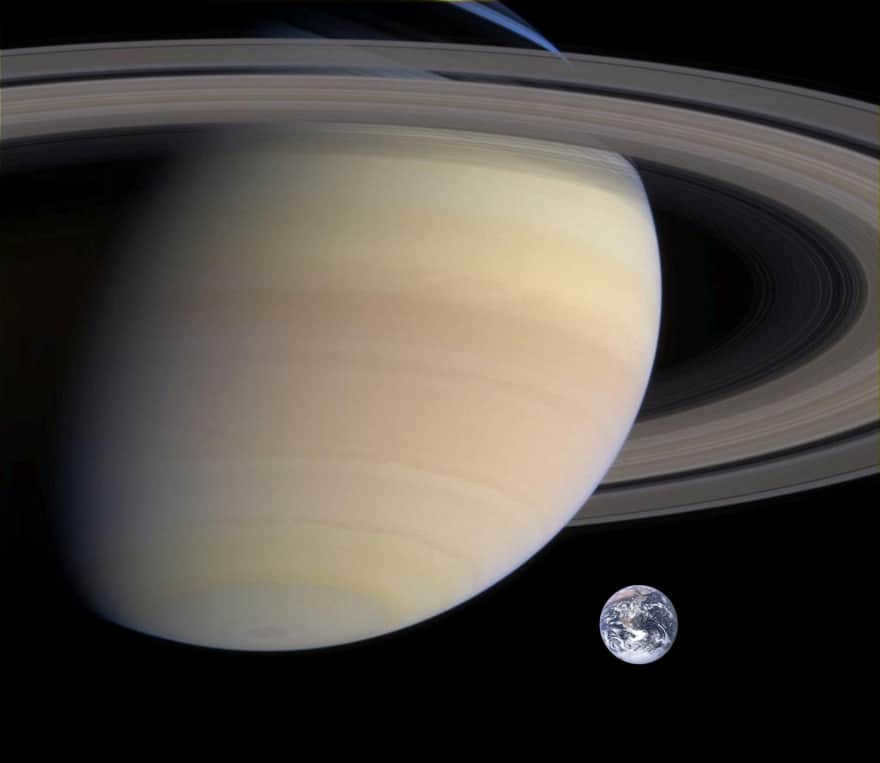
Comparing the sizes of Earth and Saturn
The average radius of Saturn is 58232 km (equatorial radius is 60268 km and polar radius is 54364 km), making it 9.13 times larger than Earth. Saturn has a mass of 5.6846 × 10 26 kg and a surface area of 4.27 × 10 10 10 km 2 , giving it a volume of 8.2713 × 10 14 km 3 .
Unique physical features of Saturn
The planet Saturn is located at a staggering distance of 1.4 billion kilometers away from the Sun. Interestingly, its maximum distance from the Sun can reach up to 1,513,783 kilometers, while its minimum distance can be as close as 1,353,600 kilometers.
A skilled tarot reader possesses the ability to provide insights into various aspects of one’s life:
What lies ahead in your future? How will your relationships unfold? What choices should you make to ensure the best outcomes?

With an average orbital velocity of 9.69 km/s, it takes Saturn 10759 days to complete one orbit around the sun. This means that a year on Saturn is equivalent to 29.5 Earth years. However, similar to Jupiter, Saturn experiences differential rotation across its regions. In terms of its physical shape, Saturn can be described as a flattened spheroid.
Saturn’s Orbit and Rotation
| 1,353,572,956 km. 9,048 astronomical units |
| 1,513,325,783 km 10.116 astronomical units |
| 1,433,449,370 km 9.582 astronomical units |
Composition and surface
You are already familiar with the nature of Saturn. It is a gas giant, composed mainly of hydrogen and gas. What is remarkable is its average density of 0.687 g/cm3. This means that if Saturn were placed in a massive body of water, it would float. Saturn lacks a solid surface, but it does have a dense core. The core is characterized by increasing heat, density, and pressure as one moves closer to its center. The detailed structure of Saturn is depicted in the photo below.
Saturn’s internal structure
Scientists believe that Saturn’s internal structure is similar to that of Jupiter. It consists of a rocky core surrounded by layers of hydrogen and helium, with small amounts of volatile substances mixed in. The core may have a composition similar to that of Earth, but its density is increased due to the presence of metallic hydrogen.
At the core of the planet, the temperature reaches a scorching 11700°C, and the amount of energy emitted is 2.5 times higher than the energy received from the Sun. This phenomenon can be attributed to the gradual gravitational contraction known as Kelvin-Helmholtz contraction. Alternatively, it may be caused by the upward movement of helium droplets from the planet’s depths into the hydrogen layer, resulting in heat generation and the removal of helium from the outer layers.
According to estimates from 2004, the core of the planet is believed to be 9 to 22 times the mass of Earth and have a diameter of 25,000 kilometers. Surrounding the core is a dense layer of liquid metallic hydrogen, followed by helium-saturated molecular hydrogen. The outermost layer extends to a depth of 1000 km and is composed of gas.
Satellites
Saturn has a total of 62 satellites, but only 53 of them have official names. Out of these, 34 satellites have diameters less than 10 km, while 14 have diameters ranging between 10 and 50 km. However, some of the inner satellites stretch from 250 to 5000 km in diameter.
The majority of these satellites have been named after titans from ancient Greek mythology. The innermost moons have relatively small orbital inclinations. On the other hand, the irregular satellites situated in the most distant regions can have orbits spanning millions of kilometers and may complete a circuit in just a few years.
Among the inner satellites are Mimas, Enceladus, Tefia, and Dione. These satellites are predominantly composed of water ice and might also have a rocky core, icy mantle, and crust. The smallest of them is Mimas, with a diameter of 396 km and a mass of 0.4 x 10 20 kg. Its shape resembles that of an egg, and it is positioned at a distance of 185,539 km from the planet, resulting in an orbital period of 0.9 days.
Enceladus, which has measurements of 504 km and 1.1 x 10 20 kg, exhibits a spherical velocity. It completes one orbit around the planet in a span of 1.4 days. Despite being one of the smallest moons in terms of size, it displays internal activity and geological processes. As a result, parallel faults have emerged in the southern polar latitudes.
The southern polar region of Enceladus is home to notable geysers. These jets play a crucial role in replenishing the E ring. They are particularly intriguing because they may indicate the existence of life on Enceladus, as the water originates from an underground ocean. With an albedo of 140%, Enceladus is among the most reflective objects in the entire system. Feel free to browse through the photographs of Saturn’s satellites below.
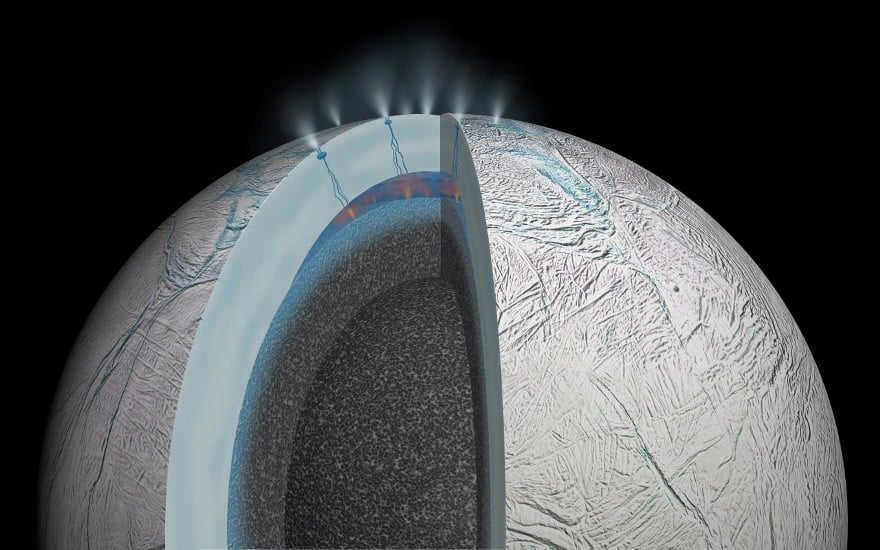

Possible hydrothermal activity happening on the seafloor of Enceladus
Having a diameter of 1,066 kilometers, Tefia is the second largest moon among Saturn’s satellites. The majority of its surface is covered in craters and hills, with a smaller amount of plains. The standout feature is the Odyssey crater, which stretches for 400 km. Additionally, there is a system of canyons that extends for 2000 km, with a depth of 3-5 km and a width of 100 km.
The largest inner moon is Dione, measuring 1112 km in diameter and weighing 11 x 10 20 kg. Its surface is not only ancient but also heavily damaged from impacts. Some craters on Dione reach a diameter of 250 km. There are also indications of past geological activity.
The outer satellites are positioned beyond the E-ring and are characterized by a composition of water ice and rock. One example is Rhea, which measures 1527 km in diameter and has a mass of 23 x 10 20 kg. It orbits at a distance of 527,108 km from Saturn and completes one orbit every 4.5 days. Its surface is adorned with craters, and the posterior hemisphere displays several prominent faults. Additionally, there are two significant impact basins, each with a diameter ranging from 400 to 500 km.
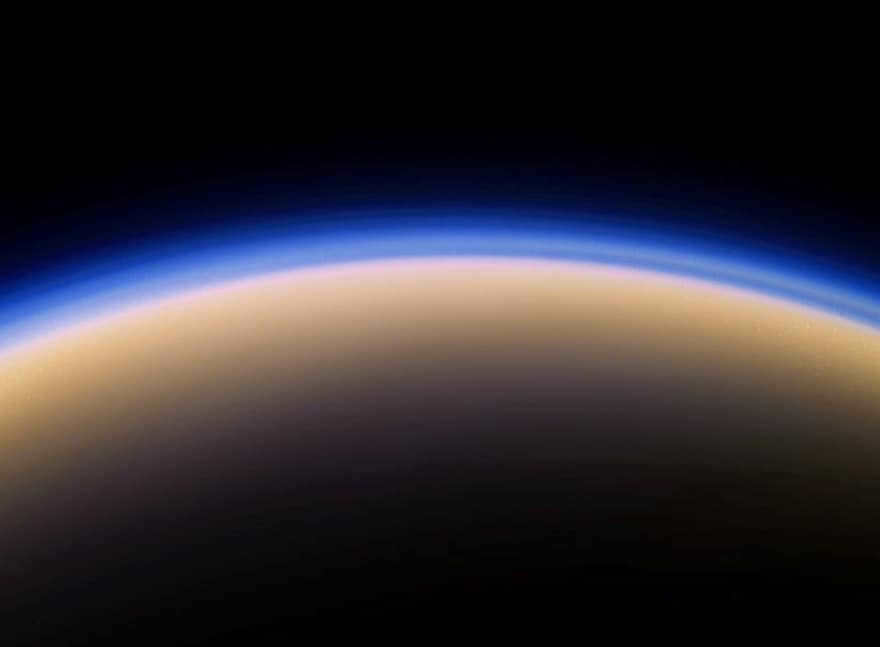

The atmosphere of Titan was captured using blue, green and red spectral filters.
Titan has a diameter of 5,150 km and a mass of 1,350 x 10 20 kg (96% of the total mass in its orbit), making it the largest moon of Saturn. It is unique among Saturn’s moons as it possesses its own atmospheric layer. The atmosphere is cold, dense, and primarily composed of nitrogen and methane. Additionally, there are trace amounts of hydrocarbons and ice crystals made of methane.
A skilled tarot reader will address the following inquiries:
What does the future have in store for you? How will your relationships evolve? What is the optimal solution?

The surface of the planet is not easily visible due to the presence of a dense atmospheric haze. Only a limited number of crater formations, cryo-volcanoes, and longitudinal dunes can be observed. What sets this planet apart from others in the system is the existence of methane-ethane lakes. Titan is located at a distance of 1,221,870 kilometers and is believed to have an underground ocean. It takes approximately 16 days for Titan to complete a full orbit around its planet.
Hyperion, on the other hand, is located near Titan. It has a diameter of 270 kilometers, making it the second largest in terms of both size and mass after Mimas. Hyperion has an irregular, egg-shaped appearance and its surface is covered in crater-like formations ranging from 2 to 10 kilometers in diameter. Unlike other celestial bodies, Hyperion does not have a predictable rotation pattern.
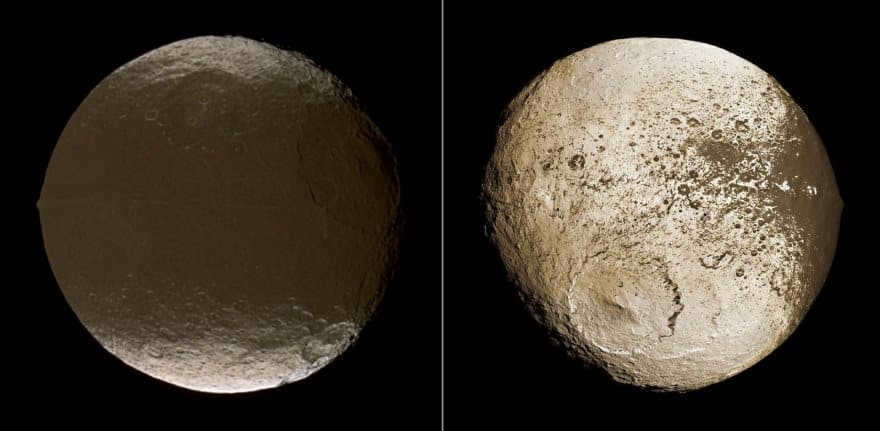
Yapet’s two sides were formed due to the contrasting materials present.
Japet measures 1470 km in length and has a mass of 1.8 x 10 20 kg. It holds the record for being the farthest moon at a distance of 3,560,820 km, which means it takes 79 days to complete its orbit. The moon’s intriguing composition is characterized by one side being darker and the other side being lighter, earning them the names yin and yang.
Now let’s talk about the irregular satellites. These small moons have retrograde orbits and can be categorized into three groups: Inuit, Gallic, and Norse.
The Inuit group consists of 5 satellites, each named after Inuit mythology: Ijirak, Kivioq, Paliak, Siarnak, and Tarkaq. These moons have prograde orbits ranging from 11.1-17.9 million km and diameters ranging from 7-40 km. Their orbital inclinations fall between 45-50°.
The Gaul family consists of the outer satellites: Albiorix, Befin, Erripo, and Tarvos. These satellites have orbits ranging from 16 to 19 million km, with an inclination of 35° to -40°. Their diameters range from 6 to 32 km, and their eccentricity is 0.53.
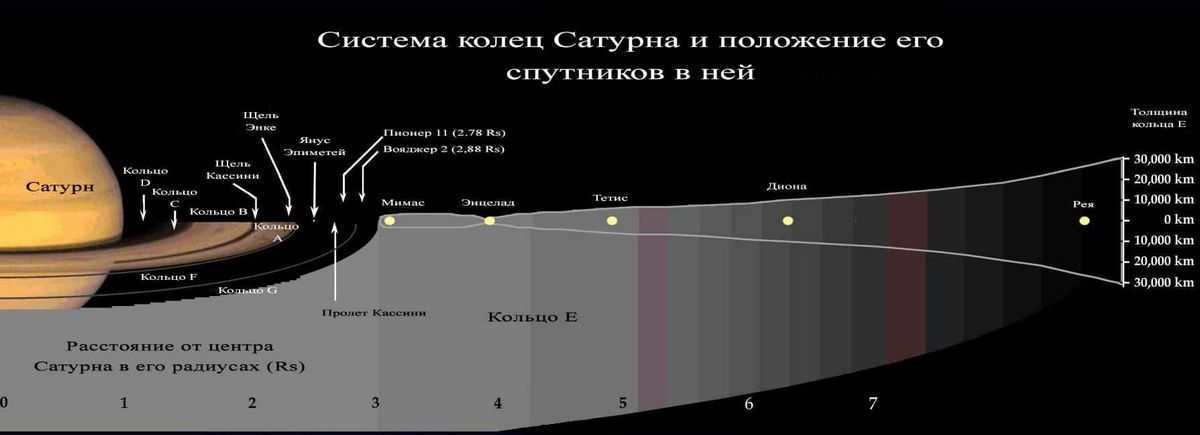

Saturn’s rings and satellites, shown to scale
There is a group of moons orbiting Saturn that are known as the Scandinavian group. These moons have a retrograde orbit, meaning they orbit in the opposite direction of Saturn’s rotation. There are 29 moons in this group, and they have diameters ranging from 6 to 18 kilometers. They are located at distances of 12 to 24 million kilometers from Saturn. The inclination of their orbits ranges from 136 to 175 degrees, and their eccentricity ranges from 0.13 to 0.77. This group of moons is sometimes referred to as the Thebes family, named after the largest moon in the group, which has a diameter of 240 kilometers. The second largest moon in this group is Imir, which has a diameter of 18 kilometers.
Between the inner and outer moons of Saturn, there is another group of moons known as the Alcoinid group. This group includes the moons Mephon, Anfa, and Pallene. These moons are the smallest satellites of Saturn. Some of the larger moons of Saturn also have their own smaller moons. For example, the moon Tephias has two smaller moons called Telesto and Calypso, and the moon Dione has two smaller moons called Helena and Polydevcus.
Composition of Saturn’s Atmosphere and its Temperature
The composition of the outer layer of Saturn’s atmosphere is primarily made up of molecular hydrogen, accounting for 96.3% of its composition, while helium makes up 3.25% of the atmosphere. Although there are traces of heavier elements present, information regarding their exact proportions remains limited. Additionally, small quantities of propane, ammonia, methane, acetylene, ethane, and phosphine can also be found in Saturn’s atmosphere. The upper cloud cover is composed of ammonia crystals, whereas the lower cloud cover consists of ammonium hydrosulfide or water. The presence of UV rays results in the photolysis of methylene, leading to chemical reactions involving hydrocarbons.


Thanks to a massive storm in the atmosphere of Saturn’s northern hemisphere, the Cassini spacecraft was able to capture an image of the planet that closely resembles its true color.
The atmosphere of Saturn appears striped, with the lines becoming weaker and broader as they approach the equator. The atmosphere is divided into upper and lower layers, with each layer having a different composition based on pressure and depth. The upper layer consists of ammonia ice and has a pressure range of 0.5-2 bar and a temperature range of 100-160 K.
Starting at a pressure of 2.5 bar, a line of icy clouds emerges and stretches up to 9.5 bar, with temperatures ranging from 185-270 K. Within this range, there are mixtures of ammonium hydrosulfide bands at pressures of 3-6 bar and temperatures of 290-235 K. The lower layer consists of ammonia in an aqueous solution at pressures of 10-20 bar and temperatures of 270-330 K.
Periodically, large oval-shaped spots form in the atmosphere. The most well-known of these is the Great White Spot, which occurs every Saturnian year during the summer solstice in the northern hemisphere.
These spots can extend for thousands of kilometers in width and have been observed in 1876, 1903, 1933, 1960, and 1990. The “northern electrostatic disturbance” observed by Cassini has been monitored since 2010. If these clouds continue to follow the same periodicity, we can expect to see the next appearance in 2020.
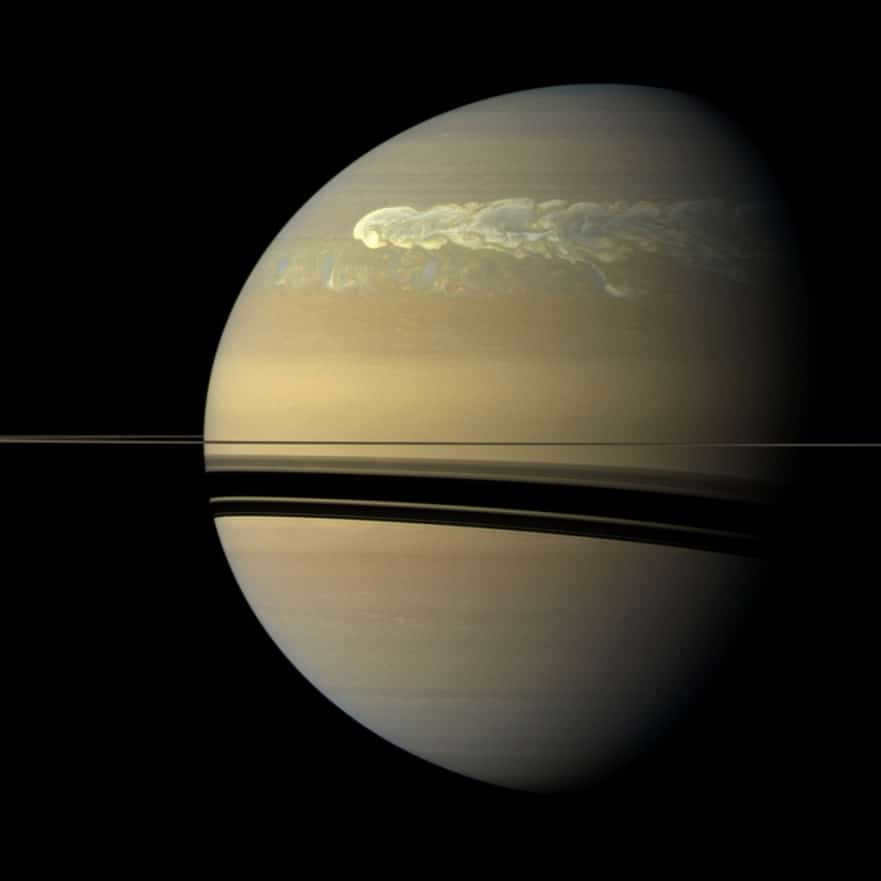
Captured by the Cassini spacecraft, there is a gigantic storm occurring in the northern hemisphere of Saturn.
In terms of wind speed, Saturn is ranked second only to Neptune. The Voyager spacecraft recorded a wind speed of 500 m/s. At the north pole, there is a visible hexagonal wave, while at the south pole, there is a massive jet stream.
The hexagonal wave was initially observed in images captured by Voyager. Its sides extend to a length of 13,800 km, which is greater than the diameter of Earth. The hexagonal structure completes a full rotation in 10 hours, 39 minutes, and 24 seconds. The vortex at the south pole was detected using the Hubble telescope. It features winds accelerating up to 550 km/h and is comparable in size to our own planet’s storms.
Rings
These rings are thought to be ancient and may have originated with the planet. There are two hypotheses. One suggests that the rings were once a moon that disintegrated due to its proximity to the planet. Alternatively, the rings may have never been part of a moon but instead serve as a vestige of the material from which Saturn itself formed.
A seasoned tarot reader will address the following inquiries:
What lies ahead in your future? How will your relationships unfold? What is the optimal course of action?

The planet is divided into seven rings, which are separated by gaps. The two densest rings, A and B, have diameters of 14600 and 25300 km, respectively. Ring B extends from 92000 to 117580 km from the center, while ring A extends from 122170 to 136775 km. Cassini’s section of the planet covers 4700 km.
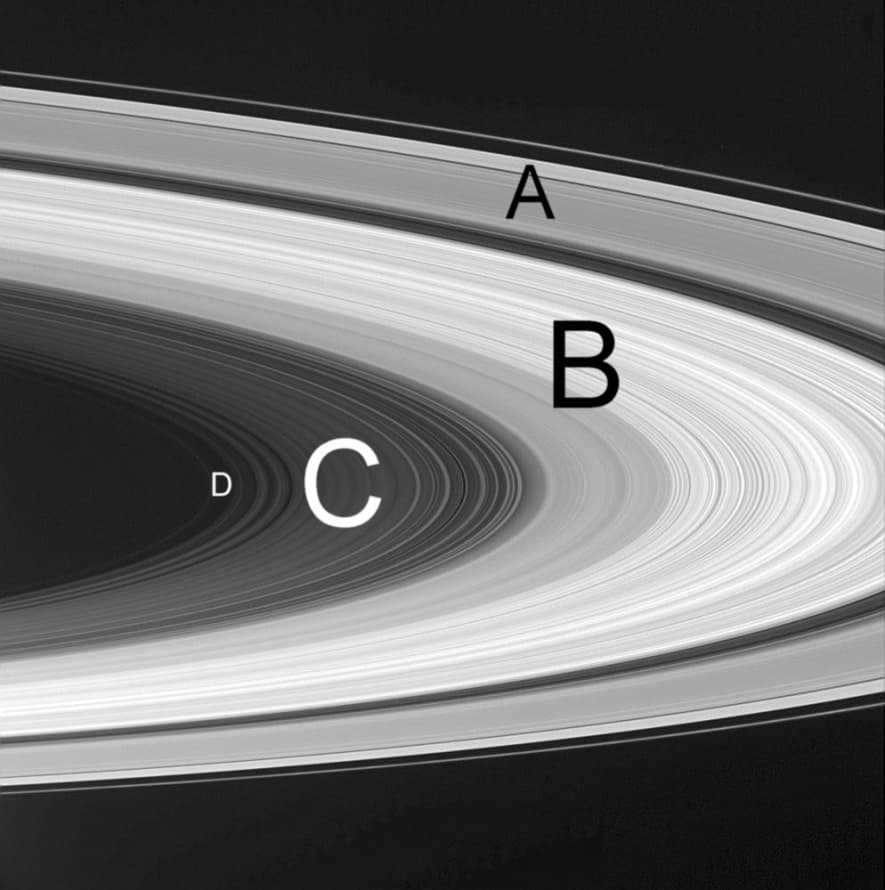
C is located 64 km away from B. A is a massive planet that stretches across 17500 km and is positioned at a distance of 74658-92000 km from the main body. A and B both host the primary rings, which consist of larger particles. Following these rings are the dusty rings, which contain smaller particles.
D occupies a space of 7500 km and extends inward for a distance of 66900-75510 km. On the opposite side, we have G, which is 9000 km wide and positioned at a distance of 166000-175000 km. E is even further, stretching across 300000 km and positioned at a distance of 166000-480000 km. F, on the other hand, is located on the outer edge of A and is more complex to categorize. It primarily consists of dust and covers a width of 30-500 km, extending 140180 km from the center.
Study History
Saturn has been observed and documented by ancient civilizations, even without the aid of telescopes. It is mentioned in numerous legends and mythologies. The Babylonians were among the first to record the planet, associating it with a zodiac sign.
The ancient Greeks referred to Saturn as Kronos, the god of agriculture and the youngest of the titans. Ptolemy was able to calculate the planet’s orbital passage during opposition. The Romans adopted the Greek tradition and gave it the name it is known by today.
In ancient Hebrew, the planet was called Shabbatai, while in the Ottoman Empire it was known as Zuhal. The Hindus referred to it as Shani, a deity who judges individuals based on their good and bad actions. The Chinese and Japanese considered it to be the earth star, one of the fundamental elements.
However, it wasn’t until 1610 that the planet was officially observed by Galileo through his telescope, where he made the groundbreaking discovery of its rings. At the time, Galileo mistakenly believed that the rings were actually two satellites. It wasn’t until later when Christiaan Huygens corrected this error and also discovered the moon Titan. Another astronomer, Giovanni Cassini, made additional discoveries of Saturn’s moons, including Japetus, Rhea, Tefia, and Dione.
Then, in 1789, William Herschel made another significant breakthrough by discovering the moons Mimas and Enceladus. Finally, in 1848, the moon Hyperion was observed for the first time.
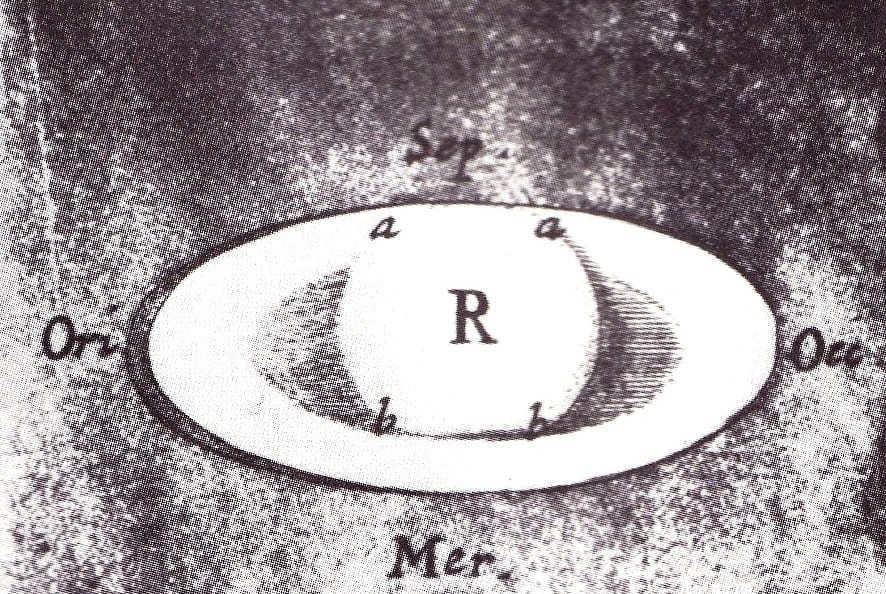
A depiction of Saturn created by Robert Hooke in 1666.
The discovery of Thebes dates back to 1899 when William Pickering hypothesized that the moon had an irregular orbit and was tidally locked to its planet. As the 20th century progressed, it became evident that Titan possessed a dense atmosphere, a characteristic not previously observed. Saturn, the sixth planet from the sun, is a captivating celestial body worth exploring. On our website, you can peruse photographs, watch videos, and uncover numerous fascinating facts about Saturn. Take a look at the map below to familiarize yourself with the planet’s layout.
Map of the surface
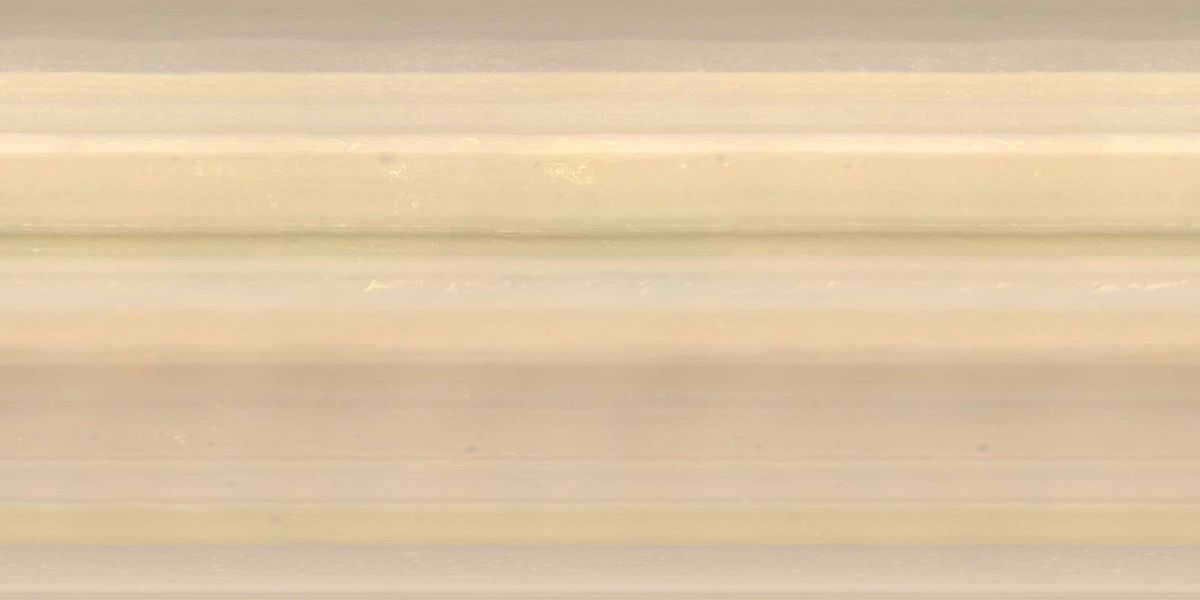

Click on the picture to see a larger version.
The position and movement of Saturn
Saturn is the sixth planet from the Sun. It is a gas giant and the second largest planet in our solar system. Saturn can be compared to a massive sphere, with a radius ten times larger than that of Earth, composed mainly of hydrogen and helium.
In addition, Saturn is surrounded by rings composed mostly of rock and chunks of ice. It orbits the Sun at a distance of approximately 1.4 billion kilometers.
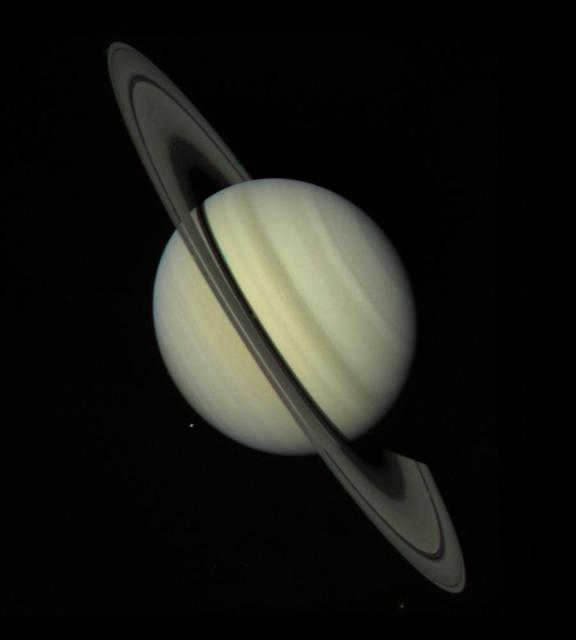
Saturn experiences relatively brief periods of daylight and extended periods of darkness: it requires approximately 10.7 hours to complete a single rotation on its axis (a day), and it necessitates 29 Earth years to complete one full orbit around the Sun.
This celestial body was given its designation as a tribute to the Roman deity Saturn (known as Kronos in Greek mythology), who represented agriculture, harvest, and was additionally regarded as the god of time. According to certain mythological tales, it was this deity who consumed his offspring.
Characterization
Characterization refers to the process of creating and developing characters in a story. It is an essential element of storytelling as it helps readers or viewers to understand and connect with the characters on a deeper level.
In literature, characterization can be achieved through various techniques such as direct and indirect characterization. Direct characterization involves the author explicitly stating the traits and qualities of a character. For example, the author may describe a character as brave, intelligent, or kind-hearted.
On the other hand, indirect characterization is when the author reveals a character’s traits through their actions, thoughts, dialogue, or interactions with other characters. This allows readers to infer the character’s personality and motivations.
Additionally, authors may use physical descriptions, such as appearance or clothing, to provide further insight into a character. They may also delve into a character’s background, including their upbringing, experiences, and relationships, to give a more comprehensive understanding of who they are.
Characterization is crucial in creating well-rounded and relatable characters. By understanding their traits, motivations, and personalities, readers can become emotionally invested in the story and develop a deeper connection with the characters. It adds depth and complexity to the narrative and helps to drive the plot forward.
In conclusion, characterization is a vital aspect of storytelling that brings characters to life. Through direct and indirect techniques, authors create unique and engaging characters that readers can connect with. It adds depth and complexity to the narrative and enhances the overall reading experience.
| 5.683E26 kg (which is 95 times the mass of Earth, 5.972E24 kg) |
| 4.27E10 km² |
| Approximately 120,536 km (which is 9.5 times the diameter of Earth, 12,742 km) |
| 58,232 km |
| The average temperature is -178°C; it gets higher as you go towards the planet’s interior (the uppermost layer is -173°C to -113°C and the lowest layer is -88°C to -3°C) |
| 82 natural satellites (53 are known and 29 are awaiting confirmation) |
| An average of 1.4 billion km (maximum 1.51E8 km, minimum 1.56E8 km) |
| 7 large rings (each named with a letter of the Latin alphabet in order of discovery) and many (500 to 1000) other rings and gaps. |
Saturn’s rings
The primary set of rings around Saturn, which were given names based on the order of their discovery (from the outermost ring to the innermost): D, C, B, A, A, F, G, E. To remember the order, you can sing the letters like the lyrics to a catchy tune, such as “Happy Birthday to You”.
Additionally, there are other rings that were named after the planet’s moons: the Janus-Epimetheus Ring, the Theba Ring, and the Pallene Ring.
Overall, Saturn boasts a large number of rings – estimated to be between 500 and 1000 – and these rings feature various gaps, such as Bond’s crevice and Colombo’s crevice.
It is commonly thought that these fragments are remnants of comets, asteroids, or satellites that disintegrated before reaching the planet and were subsequently shattered by its formidable gravitational force. Each individual particle varies in size, ranging from massive, mountain-like chunks to minuscule pebbles. Scientists hypothesize that these fragments consist of either ice or ice-coated rocks.
Collectively, they span an expanse of approximately 400,000 kilometers (slightly exceeding the distance between Earth and the Moon).
Satellites
Saturn possesses a total of 82 satellites, with 53 officially acknowledged and named, leaving the remaining 29 yet to be designated. Saturn holds the distinction of having the highest number of natural satellites within our solar system.
Among the notable satellites are:
- Mimas (Saturn’s closest satellite)
- Titan (the largest)
- Rhea (the second largest)
- Japetus (the third largest)
- Dione (the fourth largest)
- Tefia (the fifth largest)
- Enceladus (the sixth largest)
- Egeon (discovered in 2008, the 53rd satellite of Saturn)
- Hyperion (discovered in 1848)
Atmosphere of Saturn
The composition of Saturn’s atmosphere primarily consists of:
Wind speeds at the equator of Saturn can reach up to 1800 km/h, making it one of the most turbulent planets in the entire solar system.
Structure and Topography of the Planet
Saturn is classified as a gas giant, which means it lacks a solid surface but may possess a solid core at its center. Surrounding the core is a layer of liquid metallic hydrogen, followed by a mixture of molecular hydrogen and helium in a gas-liquid state. All of these layers are encompassed by an upper atmosphere.
Essentially, Saturn can be described as a massive sphere composed mainly of hydrogen and helium, devoid of any solid surface. As one delves deeper into the planet, the density and temperature progressively change. If one were to attempt walking on the surface, they would inevitably fall into the planet and be subjected to extreme temperatures and pressure, resulting in their complete obliteration.
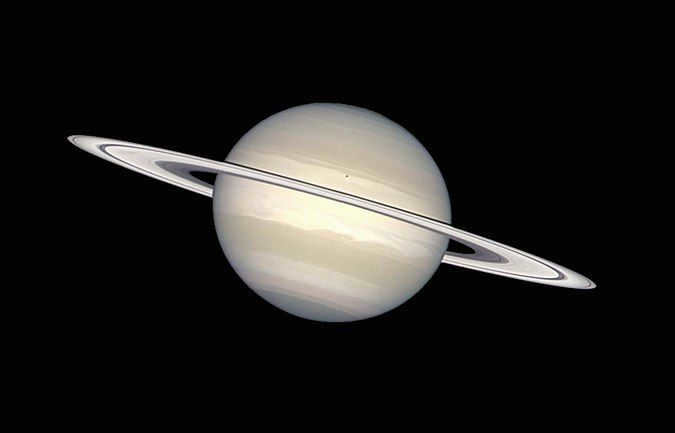
Saturn, the sixth planet from the Sun in the Solar System, is a gas giant and the second largest planet in our solar system, surpassed only by Jupiter. Saturn is renowned for its stunning rings, consisting of ice particles and cosmic debris. Positioned at an average distance of 1,430 million kilometers (9.58 astronomical units) from the Sun, Saturn takes about 10,759 days (approximately 29.5 years)[1] to complete one orbit around the Sun, traveling at an average speed of 9.69 km/s.
Comprised mainly of hydrogen and helium, with traces of other elements, Saturn’s interior features a small core composed of rock and ice, engulfed by a thin layer of metallic hydrogen, which is further surrounded by a thick outer layer of gases. The wind speeds on Saturn can reach up to 1800 km/h, surpassing those on Jupiter. Additionally, Saturn possesses a magnetic field[1].
Saturn is known for its impressive planetary ring system, which is composed primarily of ice and small particles of cosmic dust. This gas giant is also home to a total of 83 natural satellites. Notably, Titan, the largest of Saturn’s satellites and the second largest in our solar system (only surpassed by Ganymede), is actually larger than the planet Mercury itself. What sets Titan apart from other natural satellites is its significant atmosphere. In fact, it is the only moon in our solar system known to have such an atmosphere. In January 2005, a space module successfully landed on Titan’s surface, marking a major milestone in space exploration.
The name “Saturn” is derived from the Roman god of harvest and agriculture, who is the equivalent of the Greek titan Kronos. To represent this celestial body, a stylized image of a sickle (♄) is used as its symbol.
Physical attributes
Saturn is situated at an average distance of 1,430 million kilometers (9.58 astronomical units) from the Sun. It has an average orbital velocity of 9.69 km/s, which means it takes approximately 10,759 Earth days (or roughly 29.5 years) for Saturn to complete one orbit around the Sun. The distance between Saturn and the Sun varies by around 155,000,000 km due to its eccentricity of 0.056, with perihelion and aphelion marking the closest and farthest points of Saturn’s orbit to the Sun respectively[4].
Saturn has a distinctive shape, with a noticeable “flattening” near its pole and a “bulge” near its equator. The difference between its equatorial diameter (120,536 km) and its polar diameter (108,728 km) is nearly 10%. This unique shape is a result of Saturn’s rapid rotation and its liquid composition. Unlike any other planet in our solar system, Saturn has a density that is less than that of water, measuring at 0.69 g/cm3. However, despite its light atmosphere, Saturn’s core is significantly denser. In terms of mass, Saturn is much smaller than Jupiter, weighing only 95 times the mass of Earth compared to Jupiter’s 318 times the mass of Earth. However, Saturn is only slightly less massive than Jupiter, with a difference of only 20% [6].
According to current scientific understanding, the internal structure of Saturn is similar to that of Jupiter. It consists of a rocky core at its center, surrounded by layers of metallic hydrogen and molecular hydrogen. These layers also contain traces of water and ammonia crystals, as well as methane, ethane, and other substances. The total mass of these elements is estimated to be 19 to 31 times that of Earth, with the highest concentration found in the core. The temperature inside Saturn reaches a scorching 12,000 K, and the planet emits 2.6 times more heat than it receives from the Sun, indicating a high core temperature. Scientists believe that this heat is primarily generated through the Kelvin-Helmholtz mechanism, which involves the slow compression of the planet by gravity. Additionally, some of the heat may be produced internally through the deposition of helium in a predominantly hydrogen environment, as helium is heavier than hydrogen, and from the energy released due to friction between atoms.
Saturn’s atmosphere exhibits cloud belts that are reminiscent of those found on Jupiter, although they appear fainter and wider at the equator. The Voyager probes were the first to extensively study Saturn’s cloud belts. However, advancements in the resolution of ground-based telescopes have since allowed for their observation from Earth. Similar to Jupiter, Saturn’s atmosphere is known for its storms and turbulence. In 1990, the Hubble telescope detected a sizable white cloud near the planet’s equator that had not been previously observed by the Voyager probes. In 1994, another smaller storm was documented. Infrared observations unveiled a polar vortex, a type of turbulence, that stood out due to its significantly warmer temperature compared to the surrounding atmosphere, a phenomenon unparalleled in the entire solar system. While Saturn’s average temperature hovers around -185 °C, the vortex registers at approximately -122 °C [4].
Saturn possesses a magnetic field that takes on the form of a basic spherical magnetic dipole. Its intensity measures 0.2 Gauss (equivalent to 20 µTL) at the equator, making it approximately 1/20th the strength of Jupiter’s magnetic field and slightly less powerful than Earth’s. Consequently, Saturn’s magnetosphere is significantly smaller than Jupiter’s and extends just beyond the orbit of Titan. It is believed that this magnetic field is generated by a layer of metallized hydrogen, known as a metallized hydrogen dynamo, which is similar to Jupiter’s magnetic field.
Saturn’s rings
The observation of Saturn’s rings dates back to 1610 when Galileo Galilei first noticed them. At that time, he mistakenly believed that they were large satellites positioned near the planet. However, in 1655, Christian Huygens used a more advanced telescope and accurately described the rings. He realized that they were not solid but instead consisted of multiple narrow rings with gaps between them. It wasn’t until 1675 when Giovanni Domenico Cassini made the discovery that the rings are comprised of numerous particles orbiting Saturn. James Clark Maxwell further supported this theory in 1859, proving that the rings cannot be solid or they would break. Finally, in 1895, Maxwell’s theory was confirmed at the Lycus Observatory.
The rings of Saturn are visible with a regular amateur telescope or binoculars that have strong magnification. They stretch from 6,630 to 120,700 km above the equator of the planet and consist of silicate rocks, iron oxide, and ice particles of various sizes, ranging from grains of sand to small cars in size.
Satellites
Saturn possesses a significant number of natural satellites (as of March 2023, a total of 83 have been identified, excluding the numerous bodies that constitute the rings). Some satellites are relatively small, with 34 measuring less than 10 km in diameter, while an additional 13 have a diameter of less than 50 km. Furthermore, there are 3 celestial bodies that are believed to be satellites but could potentially be large aggregations of dust within the planet’s rings. The largest satellites, namely Mimas, Enceladus, Tefia, Dione, Rhea, Titan, and Japet, were first discovered in 1789 and continue to be the subject of extensive research to this day [8].
Titan, the largest moon in our solar system, stands out for its dense atmosphere, a unique feature among all the satellites. Its size is truly remarkable when compared to Saturn’s other moons. In fact, after the Sun, the eight planets, and Jupiter’s moon Ganymede, Titan is the most massive object in our entire solar system. Its diameter is a whopping 50% larger than that of the Moon. Titan holds approximately 90% of the total mass surrounding Saturn and its iconic rings. As for Saturn’s second largest moon, Rhea, scientists believe it possesses a sparse ring system. It’s worth noting that most of Saturn’s moons are named after titans from Greek mythology[9].
Study Background
The study of Saturn has a long history dating back to ancient times. As early as 700 BC, the Assyrians recorded sightings of a ringed object with a brilliant appearance in the night sky, referring to it as the Star of Niniba. In July 1610, Galileo Galilei observed the planet’s rings, although he initially mistook them for a triple planet. It was not until 1665 that Christiaan Huygens accurately identified the rings and also discovered Saturn’s largest satellite, Titan [10].
The exploration of Saturn through space missions began with the launch of Pioneer 11 on September 1, 1979. This spacecraft flew at a distance of 20,000 km above the gas giant’s upper cloud layer, capturing low-resolution photographs of Saturn itself and some of its natural satellites [10].
In November 1980, Voyager 1 made a historic visit to our planet. This incredible spacecraft transmitted back to Earth the very first high-resolution photographs of Saturn, its magnificent rings, and its fascinating satellites. Thanks to this groundbreaking mission, we were able to make numerous remarkable discoveries about the various features of Saturn’s satellites. However, despite its immense capabilities, the Voyager 1 probe was unable to capture detailed information about the topography of Titan, one of Saturn’s most intriguing moons. Fortunately, just under a year later, in August 1981, Voyager 2 embarked on its own exploration of the Saturn system. This second mission yielded even more incredible images, providing us with a closer look at the wonders of Saturn. In addition, Voyager 2 delved into the planet’s upper atmosphere, gathering valuable data on temperature and density. These missions have truly expanded our understanding of the enigmatic Saturn and its captivating celestial environment.
The spacecraft known as Cassini-Huygens was sent into space in 1997 with the purpose of studying Saturn. After a seven-year journey, it successfully reached the Saturn system and began orbiting the planet on July 1, 2004. Originally intended to last for four years, the mission’s main objectives were to analyze the composition and movement of Saturn’s rings and moons, study the behavior of its atmosphere and magnetic field, and conduct an in-depth investigation of Titan, the largest of Saturn’s satellites [10].
Notes
- ↑ 1,01,1SATURN – The Big Russian Encyclopedia – electronic version(unpublished) . old.bigenc.ru. Date of access: March 29, 2023.
- ↑Saturn Moons(not available). . NASA Solar System Exploration. Date of access: March 29, 2023.
- ↑First Landing on Titan: What the Huygens Probe Saw(unpublished) . v-kosmose.com. Date of access: March 29, 2023.
- ↑ 4,04,1Planet Saturn: description, interesting facts, exploration(unpublished) . v-kosmose.com.. Date of access: March 29, 2023.
- ↑Ker Than published.Length of Saturn's Day Revised(English). Space.com (September 6, 2007). Date of access: March 29, 2023.
- M. K. S. Online explores the mass of Jupiter in comparison to other planets in the solar system(rus.)(unpublished). ISS Online (March 29, 2023). Date of circulation: March 29, 2023.
- Hunt for a Planet: Neptune – Library delves into the search for Neptune(Russian). “Elements”. Circulation date: March 29, 2023.
- v-kosmose.com provides an in-depth analysis of Saturn’s rings, including characterization and research with photos(unpublished). Circulation date: March 29, 2023.
- v-kosmose.com explores the satellites of the planets in the Solar System(unpublished). Date of access: March 29, 2023.
- ↑ 10,010,110,210,3Saturn exploration: Saturn launches and significant dates(unpublished) . v-kosmose.com.. Access date: March 29, 2023.
This article is considered “ready”. This does not indicate the article’s quality, but it has already covered the main topic sufficiently. If you wish to enhance the article, feel free to edit it!
reaching old age
Saturn is positioned as the sixth planet from the Sun and is the second largest:
orbit: 1,429,400,000 km (9.54 a.u.) from the Sun diameter: 120,536 km (at the equator) mass: 5.68e26 kg.
In Roman mythology, Saturn was worshipped as the god of farming. He was linked to the Greek deity Cronos, who was the offspring of Uranus and Gaea and the progenitor of Zeus (Jupiter). The etymology of the English term “Saturday” can be traced back to Saturn (refer to Appendix 4).
Saturn has been a familiar presence in human knowledge since ancient times. It was Galileo who first laid eyes on the planet through a telescope in 1610, and he was quite taken aback by its peculiar appearance. The early observations of Saturn were somewhat confusing due to the Earth periodically passing through the plane of its rings, causing significant changes in the low-resolution images of the planet. However, in 1659, Christiaan Huygens accurately determined the geometry of the rings, shedding light on this celestial wonder. For a long time, Saturn’s rings were believed to be the only ones in the entire Solar System until 1977, when faint rings were discovered around Uranus, and later, Jupiter and Neptune as well.
In terms of space exploration, the first spacecraft to venture towards Saturn was Pioneer 11 in 1979, followed by the famous Voyager 1 and Voyager 2 missions. Currently, the Cassini spacecraft is en route to Saturn and is expected to reach its destination in 2004.
When observing Saturn through a telescope, the planet’s shape appears altered at the poles; its equatorial and polar dimensions differ by nearly 10% (120,536 km and 108,728 km). This is due to its rapid rotation and liquid state. The other gas giants also have a flattened shape, but to a lesser extent.
Saturn is the least dense of all the planets; its average density (0.7 g/cm3) is lower than that of water.
Similar to Jupiter, Saturn is made up of 75% hydrogen and 25% helium with small amounts of water, methane, ammonia, and “rocks”. The composition of Saturn is comparable to the initial composition of the Proto-Solar Nebula, which gave rise to the formation of the Solar System.
Saturn has a similar internal structure to Jupiter, consisting of a solid core surrounded by a layer of liquid metallic hydrogen and a layer of molecular hydrogen on the outside. Additionally, there are traces of various ices present.
The temperature within the planet is notably high, with the core reaching 12000 K. Interestingly, Saturn emits more energy into space than it receives from the Sun. While a significant portion of this energy is generated through the Kelvin-Helmholtz mechanism, similar to Jupiter, this alone does not account for Saturn’s luminosity. Another mechanism, such as the expulsion of helium from deep within the planet, may be at play.
The streaks on Saturn are less prominent compared to Jupiter. They appear much wider around the equator. Due to the inability to observe the details of these clouds from Earth, the study of Saturn’s atmospheric circulation was not possible until the arrival of Voyager 1. Similar to Jupiter, Saturn also exhibits long-lived ovals, such as the red spot in the center of the image on the right. In 1990, the Hubble Telescope captured a large white cloud near Saturn’s equator, which was not present during Voyager’s visit. Conversely, in 1994, a relatively small storm, represented by the vortex in the photo on the left, was detected.
When viewed from our planet, Saturn displays two prominent rings (A and B) and one faint ring (C). The space between the A and B rings is commonly referred to as the Cassini gap. The Cassini Division. The less distinct gaps in the outer portion of the A ring are known as the Encke Division. The Encke Division (although it’s worth noting that Encke himself most likely never observed it). In the Voyager 1 images, four additional blurry rings can be seen. Unlike the rings of other planets, Saturn’s rings are exceptionally bright (with an albedo of 0.2 to 0.6).
Even though the rings appear solid when viewed from Earth, they are actually composed of numerous tiny particles, each with its own distinct orbit. These particles vary in size from centimeters to several meters, with the possibility of even smaller objects measuring just a few kilometers.
The composition of the particles in the rings is likely to be predominantly water ice, although there is a possibility that there are also particles of solid rock embedded within the ice.
Through the Voyager mission, the presence of peculiar radial anomalies in the rings, known as “spokes,” which were initially observed by amateur astronomers (on the left), has been verified. The exact nature of these irregularities is still uncertain, but it is plausible that they are somehow linked to Saturn’s magnetic field.
The structure of Saturn’s outermost ring, known as the F ring, is highly intricate. It consists of multiple narrow rings with distinct “knots” interspersed throughout. There is speculation among scientists that these knots may be clusters of the materials that compose the rings or even miniature moons. Interestingly, the unique pattern observed in the Voyager 1 photographs (on the right) is not present in the Voyager 2 images, suggesting that Voyager 2 captured regions where the ring components align more closely in a parallel fashion.
There are tidal interactions happening between some of Saturn’s moons and the ring system: certain moons, referred to as shepherding moons (Atlas, Prometheus, and Pandora), play a crucial role in maintaining the stability of the rings; Mimas may be the reason behind the absence of debris in the Cassini gap, which is similar to the Kirkwood gaps in the asteroid belt; and Pan is located within the Encke Fission. The entire system of resonances is highly intricate and not yet fully comprehended.
The origin of Saturn’s rings (as well as those of other planets in the Jupiter group) remains a mystery. While these planets might have possessed rings since their formation, the ring systems are unstable and their material continually needs to be replenished, possibly through the destruction of larger moons.
Similar to the other planets in the Jupiter group, Saturn boasts a powerful magnetic field.
During the nighttime, Saturn can be observed with the unaided eye. While it may not shine as brightly as Jupiter, it is distinguishable as a planet due to its lack of “twinkling” like a star. The rings and prominent moons can be seen through a small telescope for astronomy. Various websites offer information on the current whereabouts of Saturn (along with other planets) in the celestial sphere. For more comprehensive and personalized maps, planetarium software like Starry Night can be utilized.
The moons of Saturn
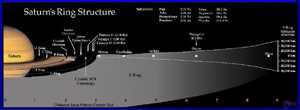
There are a total of 18 named satellites orbiting Saturn.
- With the exception of Thebes and Hyperon, all of the satellites with known rotation periods rotate synchronously.
- There are three pairs of satellites – Mimas-Tethys, Enceladus-Dion, and Titan-Hyperon – that interact gravitationally with each other. This interaction establishes a stable ratio between their orbital periods: Mimas has an orbital period exactly half that of Tethys, creating a 1:2 resonance; Enceladus-Dion also has a 1:2 resonance; and Titan and Hyperon have a 3:4 resonance.
- In addition to the 18 named satellites, there are six other potential candidates and several reported discoveries and tentative confirmations. However, only six of these potential satellites have been confirmed as real at this time.
Distance Radius Mass Satellite (1000 km) (km) (kg) Discovered By When
1. Pan (Pan) 134 10 ? Showalter 1990
2. Atlas 138 14 ? Terrile 1980
3. Prometheus 139 46 2.70e17 Collins 1980
4. Pandora 142 46 2.20e17 Collins 1980
5. Epimetheus 151 57 5.60e17 Walker 1980
6. Janus (Janus) 151 89 2.01e18 Dollfus (Dollfus) 1966
7. Mimas 186 196 3.80e19 Herschel 1789
8. Enceladus 238 260 8.40e19 Herschel 1789
9. Tethys 295,530 7.55e20 Cassini 1684
10. Telesto 295 15 ? Reitsema 1980
11. Calypso 295 13 ? Pascu 1980
12. Dione 377 560 1.05e21 Cassini 1684
13. Helene 377 16 ? Laques 1980
14. Rhea 527 765 2.49e21 Cassini 1672
15. Titan 1222 2575 1.35e23 Huygens 1655
16. Hyperion 1481 143 1.77e19 Bond 1848
17. Iapetus 3561 730 1.88e21 Cassini 1671
18. Phoebe 12952 110 4.00e18 Pickering 1898.
Saturn’s Rings
* * * Name Radius Radius Width Approx. approx. approx. approx. inner outer. position mass (kg) ———————————— ——- ——- —— ———- ———– D-Ring 67,000 74,500 7,500 (ring) Guerin Division (Guerin Division) C-Ring 74,500 92,000 17,500 (ring) 1.1e18 Maxwell Division (Maxwell Division) 87,500 88,300 500 (division) B-Ring 92,000 117,500 25,500 (ring) 2. 8e19 Cassini Gap (Cassini Division) 115,800 120,600 4,800 (division) Huygens Gap 117,680 (n/a) 285-400 (subdiv.) A-Ring ** 122,200 136,200 14,600 (ring) 6. 2e18 Encke Minima 126,430 129,940 3,500 29%-53% Encke Division 133,580 325 78% F-Ring 141,210 30-500 (ring) G-Ring 165,800 173,800 8,000 (ring) 1e7? E-Ring 180,000 480,000 300,000 (ring) Notes: * Distance is measured in kilometers from the center of Saturn ** The term “Enke’s Minimum” is used by amateur astronomers, but it is not recognized by the IAU.
Learn more about Saturn and its moons
- Additional pictures of Saturn
- Provided by LANL
- Available from ASU
- Obtained from JPL
- Accessible through RPIF
- Featured on Stardate
- Retrieved from RGO
- Found on NSSDC
- Provided by NASA Space Links
- Saturn events from TAMU
- Explore Saturn’s ring system
- Discover the reasons behind the gaps in the rings on Phil Plates’ best Bitsize Astronomy site
- View the Saturn’s Rings Plot 1995-1996, which includes information about Saturn and its rings
- Read the Voyager Saturn Science Message
- Learn about the Transverse Plane of Saturn’s Rings with information from JPL and images from STScI
- Witness the Sun Crossing the Plane of Saturn’s Rings captured by WIYN Observatory
- Explore Historical Summaries of Saturn’s Rings and Satellites provided by JPL
- Refer to the Saturn System Nomenclature Table
- Rings of Saturn Spaces, Official IAU Nomenclature Table, by Jeff Madcuff (pdf)
Unresolved Questions
- How is Saturn able to generate heat internally?
- What causes the formation of the “spokes” on the rings?
- What is the origin of Saturn’s rings and what insights can they provide about the formation of the Solar System as a whole? Why do Saturn’s rings differ so significantly from other planetary rings?
- If everything goes according to plan, Cassini will enter Saturn’s orbit in 2004. Along with providing a comprehensive view of Saturn and its major moons, it will also deploy the Huygens probe (developed by the European Space Agency) to the surface of Titan.
A journey to Titan

Saturn is a celestial object located in our solar system that is commonly taught to students even at a young age. In terms of its position relative to the Sun, it is the sixth planet. It is unique among all the planets as it is the only one whose rings can be observed without the aid of a telescope. It is widely regarded as one of the most visually stunning planets in our solar system. It is quite easy for anyone, including young students, to identify Saturn among other celestial bodies.
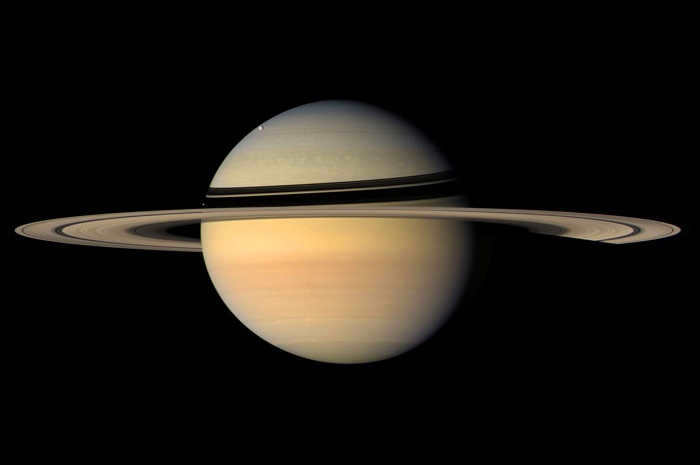
The unique planet received its designation from the ancient Romans, in recognition of the deity who protected landowners. The renowned Galileo Galilei was the initial person to observe the planet. During that era, telescopes lacked precise optical capabilities, causing the astronomer to mistake the ring’s contours for satellites. It was not until later on that the Dutch engineer Christian Huygens succeeded in demonstrating that the indistinct outlines surrounding the planet were indeed rings. Furthermore, this same scientist was the first to identify Saturn’s moon, currently known as Titan.
Overview of Saturn
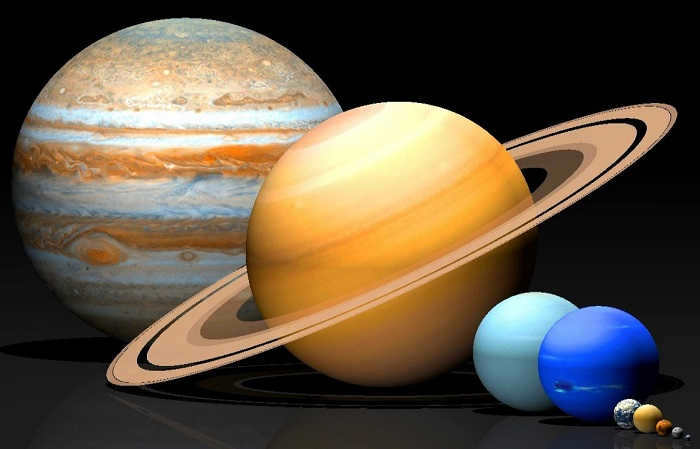
Displaying the relative sizes of various planets: Jupiter, Saturn, Uranus, Neptune, Earth, Venus, Mars, and Mercury Saturn, similar to its gas planet counterparts Jupiter, Uranus, and Neptune, lacks a solid surface, with its upper mantle comprised entirely of gases. Saturn completes a full rotation on its axis in approximately 11 hours, a duration equivalent to nearly one Earth day.


Saturn is characterized by its dull yellow hue, which is a result of the ammonia clouds found in its atmosphere. The planet’s iconic rings can be observed using a 15 millimeter telescope. To reach Saturn from Earth, a continuous journey of approximately 7 years would be required.
The duration of one full orbit around the Sun is 30 Earth years. Unlike the rest of the planets in the solar system, its orbit is not perfectly circular.
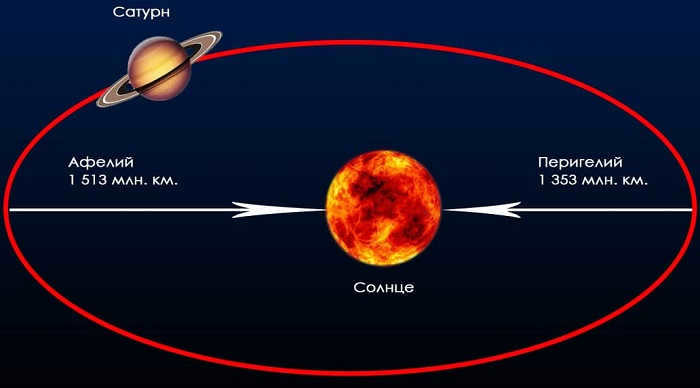
Seasonal changes occur due to the elliptical shape of the orbital paths. The point in the orbit closest to the Sun is called perihelion, while the most distant point is known as aphelion. Ever since the Italian physicist Galileo Galilei observed the planet through an ancient telescope in 1610, over 13 complete Saturnian years have elapsed. In other words, Saturn has completed a full orbit around the Sun 13 times since then.
The physical characteristics of the planet
The planet’s internal makeup closely resembles that of other gas planets. The atmosphere and mantle have comparable densities, resulting in a lack of distinct boundaries between them. However, the main difference lies in their composition.

- The core of Saturn consists of a mixture of water ice, metals, and silicon chlorides;
- The mantle, which is the upper layer, is primarily composed of hydrogen metal;
- Saturn has an equatorial diameter of 120,540 km, which is ten times larger than the diameter of the Earth;
- The radius of Saturn is approximately 58,232 ± 6 km;
- At the poles, Saturn is slightly flattened in shape;
- The average temperature on Saturn varies around -170 degrees, with lower temperatures in the deeper layers;
- Saturn has a mass of 5.68×10^26 kilograms, which is 95 times larger than the mass of the Earth;
- The acceleration due to gravity on Saturn’s equator is 10.44 m/s^2, which is only slightly higher than on Earth;
- The density of Saturn is 0.687 g/m^3.
Saturn is one of the largest planets in the solar system and possesses a significant gravitational force. However, the gravity on Saturn is comparable to that of Earth.
Saturn shares similarities with Jupiter in terms of its characteristics and composition of its atmospheric air. The upper layer is primarily composed of 91% hydrogen and 9% helium.

Occasionally, dense clouds containing methane, ammonia, and ethane pass by. The layer closest to the mantle contains vaporized hydrogen oxide and ammonium sulfide.
Saturn has earned the nickname “the planet of storms” due to the constant rotation of its atmospheric masses. Powerful winds blow at speeds of 1800 kilometers per hour, exclusively in an eastward direction. The most intense storms occur near the equator.
Saturn experiences lightning that is significantly stronger and larger than what is observed on Earth.
Rings of Saturn
When discussing this celestial object, the first thing that comes to mind is the presence of its rings. Over the course of centuries, numerous theories have been proposed in the fields of astronomy, astrology, and other cosmic sciences to explain their origin.
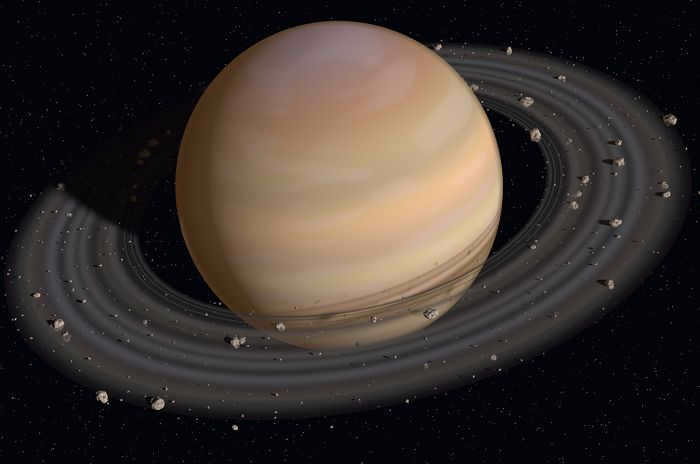
There are several possible explanations for the formation of Saturn’s rings:
- It is possible that Saturn’s powerful gravity prevented the formation of a small object near it.
- Another possibility is that a collision with another celestial body caused the scattering of material around the planet, forming the rings.
- Alternatively, it is possible that the young primary satellites of Saturn were engulfed by its gravity, contributing to the formation of the rings.
The origin of Saturn’s rings remains a topic of great interest for scientists, as there is no definitive evidence explaining their formation. However, one thing is clear: the rings are younger than the planet itself. The ice in the rings is pure, which suggests that it did not form at the same time as the planet, around 4 billion years ago.
Surprisingly, the rings were “misplaced” in 1995, with a similar incident occurring in 2009. It appears that they were not vanishing, but rather the planet was appearing ribbed from Earth’s perspective.
Scientific Investigation
The examination of the planet commenced promptly after the initial foray into space. In 1979, a satellite transmitted the inaugural images of Saturn to Earth, a momentous contribution to the field of space exploration that persists to this day.
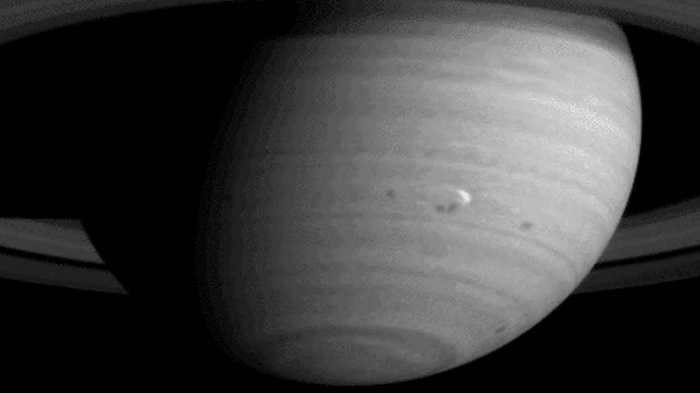
In 1980, the Voyager spacecraft collected valuable data on the temperature and composition of the atmosphere of this fascinating planet. Additionally, it captured detailed information about the satellites and rings surrounding it, providing scientists with a deeper understanding of its complex structure. Moreover, the Voyager mission resulted in the acquisition of more distinct images of the planet, allowing researchers to explore its magnificent features in greater detail.
During the early 1990s, the Hubble Space Telescope played a crucial role in further advancing our knowledge of this planet. It captured highly detailed images of its satellites and rings, which scientists eagerly utilized to conduct new studies and calculations. These images opened up new avenues for research and expanded our understanding of this mesmerizing celestial body.
In 1997, the Cassini-Hugens mission embarked on a remarkable journey to explore this captivating planet. After an impressive seven-year voyage, the Hugens probe successfully landed on the surface of Titan, one of its largest satellites, providing invaluable insights into its terrain and composition. Meanwhile, the Cassini spacecraft diligently transmitted data about this extraordinary planet back to Earth until 2017, enriching our knowledge of its mysteries and wonders.
Curious information about the celestial body Saturn
The planet Saturn possesses some remarkable characteristics.
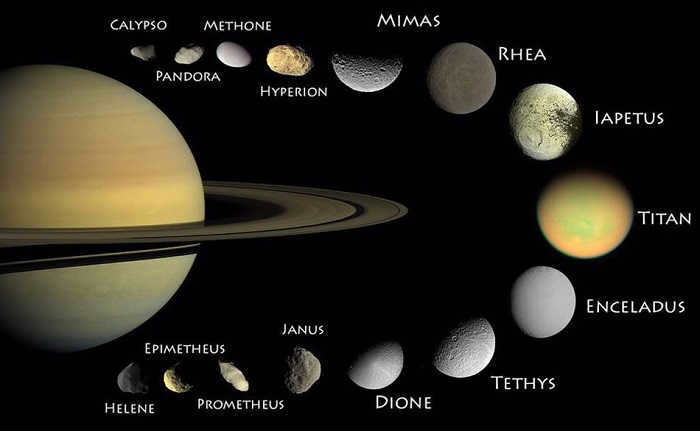

The largest moons of Saturn
Here are some fascinating details:
- Among all the moons, Enceladus, the sixth largest, is believed to have the potential for life beneath its icy surface;
- Saturn is the most oblate planet, with its polar diameter approximately 1.2 times smaller than its equatorial diameter;
- It is less dense than water, weighing 44% less. Despite its massive size and weight, Saturn wouldn’t sink if placed in water;
- In ancient Roman mythology, Jupiter was said to be the son of Saturn;
- The rings are less than a kilometer thick but span tens of thousands of times wider;
- The combined mass of Jupiter and Saturn accounts for over 90% of the total mass of the entire solar system;

